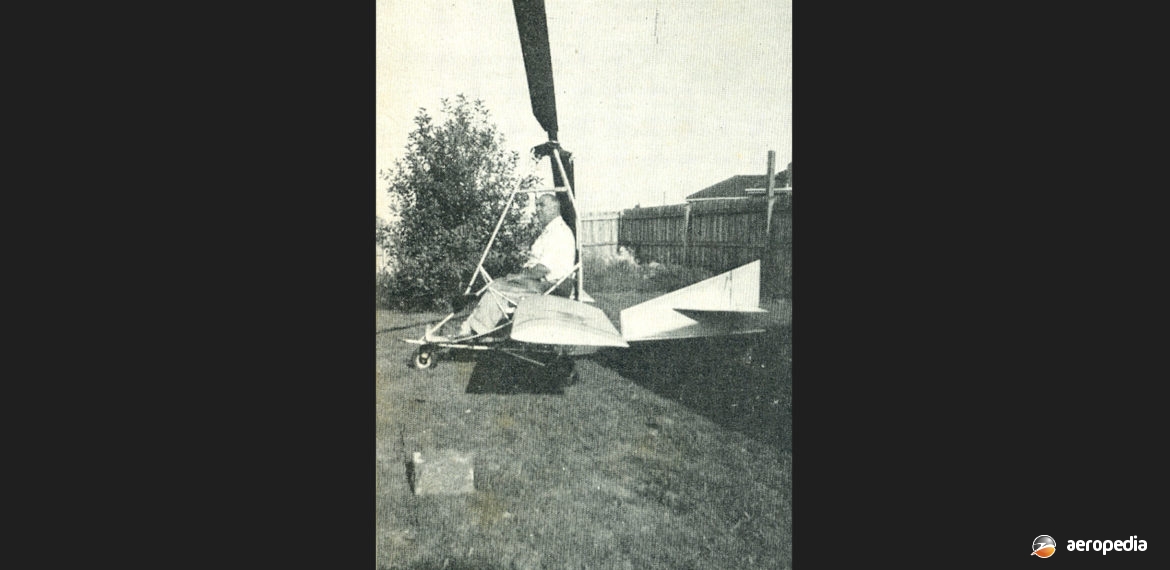Photograph:
Williams Lennycopter during construction with the designer in the seat (Author’s collection)
Country of origin:
Australia
Description:
Single-seat sport gyrocopter
Power Plant:
One 52 kw (70 hp) Uttermohle three-cylinder air-cooled radial engine
Specifications:
- Rotor span: 6.09 m (20 ft)
- Rotor chord: 19 cm (7½ inches)
- Rotor incidence: +4 degrees
- Rotor rpm: 350
- Minimum flying speed: 24 to 29 km/h (15 to 18 mph) at full load
- Empty weight: (118 lb)
History:
In the early 1960s Mr Leonard Williams designed and constructed a gyrocopter known by his friends as the Lennycopter. Mr Williams was born and lived in the United Kingdom and built the first aeroplane of his own design in 1916. At that time he was studying airframe construction and repair at RAF Cranwell in Lincolnshire. After World War I he worked for a number of British aviation companies, including de Havilland, Bristol, and Avro. In 1936 he became an airframe inspector for Airwork, and later worked at the Hills and Son Ltd, also known as Hillson, at its Manchester facility. After World War II he spent some time working for Percival Aircraft before migrating to Australia in 1957 where he commenced employment at the Government Aircraft Factory.
At the age of 61 years he decided to build the Lennycopter which, although resembling the Bensen Gyrocopter series, was dissimilar in many respects. Much of the design stemmed from the designer spending some time working with Raoul Haffner, a helicopter specialist in the United Kingdom. The aim was to build an airframe of T-45 tube which would have the advantage of simplicity of construction and a good STOL performance. He installed a deep-section monoplane wing to the fuselage to relieve the rotor of some of its flight load and to contribute to overall lift. At 113 km/h (70 mph) the wing produced 113 kg (250 lb) of lift. He was also of the view that if, by chance, the machine suffered rotor damage or failure in flight the pilot would be assisted by the stub-wings.
The stub-wings were claimed to reduce the take-off run to minimal proportions, as well as easing gust loads on the rotor. Initial testing was carried out by being towed behind a motor vehicle, an engine not being fitted at this stage, this testing commencing in mid-1963 and including flights with and without the stub-wings. It was said the stub-wings made no difference to control reactions but improved lift and slow-speed manoeuvrability. It was planned to develop the design to the stage where flight would be permitted with the engine fitted.
At that time suitable lightweight engines were few and far between but Mr Williams obtained advice from German-born engine researcher, Dr Uttermohle, who was at that time residing in Melbourne. He had developed a three-cylinder radial engine which by that time had run several hundred hours of bench testing, this being an air-cooled, two-stroke, unit with fuel injection which developed 52 kw (70 hp) for a weight of 32 kg (70 lb). The engine was in the form of an inverted “Y” and was 53.34 cm (21 in) in diameter.
However, it seems, like with a lot of promising designs, finance was a problem and although the Uttermohle engine development was undertaken at the request of Mr Williams, that engine did not become available. The decision was made to install an American Harlequin engine, a unit developed from the Harley-Davidson motor cycle engine which was not considered, because of its weight, to be adequate. It seems in the end the promising Uttermohle engine and aircraft ended up doomed to obscurity due to a shortage of funds. The ultimate fate of the machine is not known.

